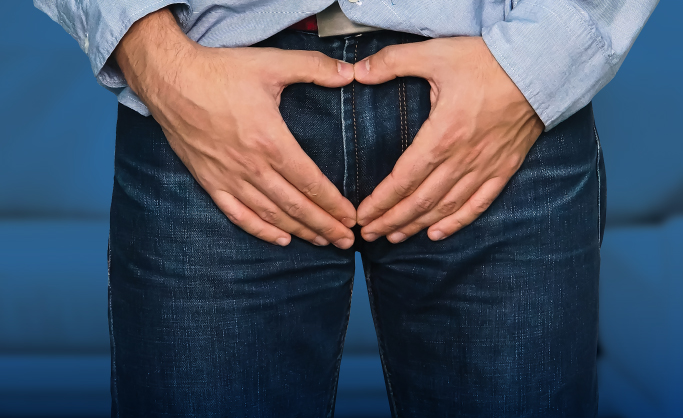Your diet
Discover our animated video!
The role of hormone therapy.
Has your doctor recommended hormone therapy to treat your prostate cancer? This video is for you! When it comes to hormone therapy, it pays to know the facts. Let’s take a closer look.
The role of food
The importance of healthy eating
Eating well starts with eating a variety of foods every day in order to get all the essential nutrients of a healthy diet. In fact, food is one of the first risk factors that we think about when it comes to prostate cancer.
Men in western countries, such as North America, are more susceptible to cancer than men in eastern Asian countries like China and Japan. That being said, Asian men living in North America for at least one generation are subject to the same risks as North Americans that have been here for a number of generations.
This may be because western diets contain less fruit and vegetables and more meat, dairy products, sugar, fat, and processed foods. In fact, food is one of the first risk factors that we consider when it comes to prostate cancer.
What is a healthy diet?
It’s all about balance, moderation, and variety. A healthy diet—containing a lot of fruit and vegetables, fibre, low-fat proteins (fish, poultry, and lean meat), and only a little fat and salt—helps you maintain a healthy weight. Research shows that maintaining a healthy weight reduces your risk of prostate cancer.
Good nutrition is important at every stage of your prostate cancer journey. Clinical research suggests that a heart-healthy diet can lead to a better prognosis, while also protecting your heart health. Maintaining a healthy lifestyle – through diet and physical activity – can set you up for success by improving your energy, strength and overall health.
Following the Canadian food guide can help:
- Meet your vitamin, mineral and other nutrient needs
- Reduce your risk for heart disease
- Contribute to your overall health and energy
This guide shows how many servings of each food group men ages 51+ should aim to consume per day. Do not hesitate to speak to a dietitian or to a nutritionist and do not take supplements or natural products without talking to your doctor.

Servings for men
Vegetables and fruits (7-9 servings)
- Aim to eat at least one dark green and ne orange vegetable per day. Romaine lettuce, spinach and broccoli are examples of dark green vegetables. Sweet potatoes, carrots and squash work well as orange vegetables.
- Look for fruit and vegetables that are steamed, baked or stir-fried – and avoid those that are deep fried. It’s best to choose vegetables and fruits that are not prepared with lots of added salt, fat or sugar
- Choose whole fruits and vegetables more often than juice, to meet your daily servings goal.
Grain products (7 servings)
- Whole-grain products should make up at least half of your daily grain product servings. Look for whole grain options such as barley, brown rice, quinoa, oats, wild rice, whole grain breads and pasta.
- Compare nutrition facts – and choose grain products lower in salt, fat and sugar.
Milk and alternatives (3 servings)
- Choose lower fat milk products. For products made from milk (such as cheeses or yogurts), compare nutrition facts and select options that are lower in fat
- Drink milk every day. You should aim to drink 2 cups of milk per day to make sure you’re getting enough vitamin D. Choose either skim, 1% or 2% milks, or fortified soy beverages
Meat and alternatives (3 servings)
- Look for lean meats and alternatives that have limited added salt and fat. Remove skin on poultry and visible fat on meat. Bake, roast or poach prepared meats and alternatives. When choosing pre-packaged meats, compare nutrition facts and choose those with less sodium and fat
- Eat at least 2 servings of fish per week. For example, you could choose to eat herring, char, mackerel, salmon or trout
Making healthy choices
When choosing which foods to eat, it’s generally best to eat a diet that is:
Plant-based
Try to eat lots of fruit and vegetable servings. Beans, legumes and whole grains also work well.
Low in saturated fat
Try reducing or eliminating your intake of high fat meats, milk and other dairy products. Try limiting your consumption of butter, mayonnaise and baked goods.
High in fibre
Whole grain breads, oats, barley, quinoa and bulger are all high-fibre choices.
Low in simple sugars
Aim to limit your intake of candies, baked goods, and other foods made with simple sugars and refined flours.
Low in salt
Prepared foods can contain high levels of salt – so try to choose reduced-salt prepared meals, canned soups, snacks (unsalted or lightly salted nuts and chips) and condiments (reduced sodium soy sauce and ketchup). Using salt substitutes and using more herbs and spices while cooking can also help provide flavour without the added salt.
Tips for eating well
These tips can help you keep your body well-fueled:
Indulge in snacks
Eat smaller, more frequent snacks, every few hours, throughout the day. If appetite is an issue, don’t be shy about treating yourself to your favourite foods – your body may need the calories.
Eat more protein
Protein is important to help your cells grow and repair themselves. Try to eat more fish, poultry, lean red meat, eggs, dairy products and nuts.
Drink more water
Drinking water regularly is important for staying hydrated. You should aim to drink more water when you’re out in hot weather, or involved in physical activity.
Consider supplements
Different varieties of milkshakes, bars or powders are available at most pharmacies, and can be useful sources of protein and calories when you’re on the go or simply don’t have the time or energy to prepare a meal for yourself.
Add fruits and vegetables to your diet
Fruits and vegetables are one of the most important parts of a healthy lifestyle. A healthy diet filled with colourful fruits and vegetables are strongly linked to the prevention of chronic diseases such as prostate cancer, cardiac diseases, and diabetes.
Consuming at least 7-9 portions a day, particularly vegetables from the cruciferous vegetable family (broccoli, cauliflower, Brussels sprouts, etc.), is both reasonable and healthy if you want to prevent or slow the progression of a disease. Fructose, a natural fruit sugar, triggers the production of a specific form of vitamin D (see below) which plays a role in lowering the risk of advanced prostate cancer. Thus, eating fruits and vegetables does not have any risks and can actually be good for you Fruits and vegetables are:
- low in fat and calories: Fruits and vegetables are among the most calorie-dense foods: a single portion of vegetables contains about 50 calories while a portion of fruits contains about 70. By simply increasing your daily consumption of fruits and vegetables, you can lower your total calorie intake. This can help you maintain a healthy weight while reducing your risk of developing various cancers and diseases like prostate cancer.
- rich in fibre: Fibre keeps food moving through your digestive tract. This helps eliminate toxins and cancer-causing compounds before they can do any harm.
- an excellent source of vitamins and minerals: Some nutrients found in fruits and vegetables, such as folic acid, vitamin C, vitamin E, flavonoids, and phytochemicals are linked to prostate cancer prevention.
- a rich source of antioxidants: Antioxidants help to slow and prevent the development of cancer by protecting against DNA damage and blocking the formation of cancer-causing chemicals.
Eating a variety of fruits and vegetables every day can help reduce your risk of cancer. In general, fruits and vegetables with the most colour (dark green, red, yellow, and orange) contain the most nutrients.
Superfoods give you a lot of energy, make you feel great, strengthen your body’s immune system, and boost your ability to fight off cancer and other diseases.
In summary
- Eat a variety of foods
- Include protein in every meal
- Drink plenty of fluids
- Consume more plant-based foods
- Eat more vegetables and fruits
- Choose healthier fats, in other words, leaner meats
- Choose low-fat dairy products
- Make whole grains your preferred carbohydrates
- Limit high-calorie, high-fat snacks
- Limit processed foods that are high in sodium
Tips for a healthy lifestyle
- Limit your alcohol consumption
- Maintain a healthy body weight
- Exercise for a minimum of 150 minutes every week
Anti-cancer food

Myth versus Reality
Can certain foods reduce my risk of prostate cancer? No single food on its own contains all the anti-cancer properties capable of acting on all the processes involved in tumour development. This fact underscores the importance of integrating a wide variety of foods into our diet. For example, consuming cruciferous vegetables or vegetables from the Allium family (like garlic) help the body to eliminate carcinogenic substances, thereby reducing your body’s capacity to induce mutations in DNA and promote the appearance of cancer cells. Similarly, green tea, berries, and soy prevent the formation of new blood vessels required for the growth of micro-tumours and keep tumours in a latent state (anti-angiogenic effect). But what about their cancer-fighting properties?
Tomatoes
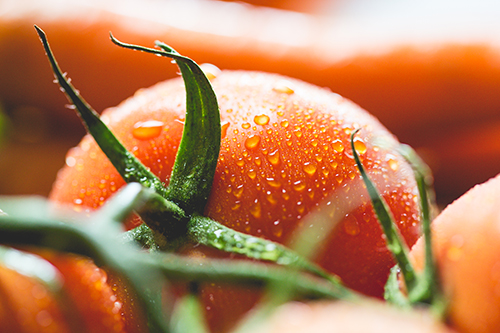
Tomatoes are an excellent source of lycopene, a strong antioxidant that helps prevent cellular damage. According to a number of studies, lycopene plays an important role in the prevention of prostate cancer. While cooked tomatoes provide the greatest benefits, Lycopene can also be found in watermelon, pink grapefruit, guava, papaya, blood orange, and apricot.
Benefits of tomatoes
Of all the carotenoids known today, we know that Lycopene is the strongest carotenoid antioxidant.
When it comes to treating prostate cancer, lycopene is a key intracellular antioxidant. Major sources of lycopene are processed tomato products such as juice, soup, paste, and sauce. Other sources of lycopene include watermelon and guava. About 50 mg of lycopene per day is recommended.
Several studies have shown that lycopene supplementation can have a beneficial impact on a variety of aspects of prostate cancer, including slowing tumour growth and causing cellular death of established human prostate cancer cells.
How to eat them?
Tomato skin contains more antioxidants (phenolic compounds, vitamin C, and lycopene) than its flesh and seeds. Processing tomatoes (cooking, crushing, etc.) increases the body’s absorption of lycopene. Cooking the tomato with fat, like olive oil, further increases the amount of lycopene that can be absorbed by the body.
Results obtained show that to see a significant result, you need to consume a lot of lycopene. That’s why it is important to choose lycopene-rich products that are easily digested by the human body. Tomato sauce is an excellent solution. If you prefer a supplement, it is recommended that you take 20–50 mg a day.
- 1 medium-sized guava or 2 tbsp. of ketchup (5 mg)
- Watermelon, 1 cup (8 mg)
- 1 pink or red grapefruit (2mg)
- Spaghetti sauce, tomato sauce (20 mg)
- Tomato paste, 2 tbsp. (10 mg)
- 1 cup or a box of diced tomatoes or salsa (12 mg)
- V8, 100% vegetable juice, 8 oz. (17 mg)
- Tomato juice, 8 oz. (22 mg)
Berries
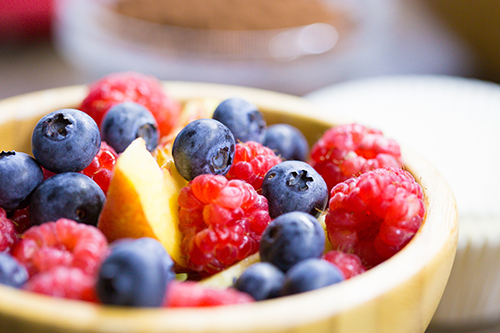
When it comes to health, berries have a fabulous reputation. Blueberries are packed with antioxidants, called anthocyanins, that may help keep memory sharp as you age, and raspberries contain ellagic acid, a compound with anti-cancer properties. All berries are great sources of fiber, a nutrient important for a healthy digestive system. Red berries like strawberries, raspberries, blueberries, blackberries, and cranberries—contain a large amount of antioxidants that help protect the body from cellular damage.
Benefits of berries
Ellagic acid is primarily a detoxifier for cells. It prevents the transformation of several carcinogens – found in the environment – into substances toxic to the cells and causes them to lose their capacity to act on the DNA and thus to induce the mutations which can trigger cancer.
Ellagic acid also helps to prevent angiogenesis, i.e. the formation of new blood vessels from pre-existing vessels allowing cancerous tumors to live.
This polyphenol is found mainly in raspberries and strawberries. However, 90% of this molecule is found in the raspberries seeds, which makes its assimilation by the organism difficult. On the other hand, the molecule is present almost entirely in the strawberry pulp.
Cherries, on the other hand, contain glucaric acid which has the capacity to detoxify our body of xenoestrogens, also known as “endoctrinal disrupters” which are pollutants present in the environment.
The second type of polyphenols found in these fruits are the anthocyanidins to which we owe the bright color of these fruits. They are characterized by a high antioxidant potential. They are mostly present in blueberries. Raspberries, strawberries and cranberries also contain them, but in smaller quantities.
Finally, berries are composed of proanthocyanidins, molecules with very strong antioxidant power. It has been established in laboratory that the addition of these molecules inhibits the growth of different cancer cells especially those derived from the colon. These polyphenols strengthen the blood vessels, improve the oxygen distribution to the cells and can keep the microtumors in a latent state by preventing them from using the blood vessels by angiogenesis. These molecules are found in abundance in seeds, barks and flowers. But their significant presence in blueberries and cranberries should be emphasized.
How to eat them?
These fruits can be consumed raw or frozen. Although cooking them doesn’t make them lose much of their phytochemical components, it is still better to eat them raw or frozen. Avoid jams or juices as a general rule since they contain too much sugar.
N.B.: Because of its drying process, there are more antioxidants in dried cranberries than in fresh cranberries. Avoid cranberry juice which has lost a lot of its phytochemical molecules.
Choosing your berries
Berries must be firm but ripe, as they will not mature once they have been harvested, with no mildew.
Conservation
- A few days in the central part of your fridge. Get rid of excess moisture with a paper towel, then place them in a perforated bag. Rinse before eating.
- Place whole fruits, peeled or not, on a plate. When frozen, place them in a freezer bag.
- Dry cranberries. Place in a sealed container, keep cool, dry and away from light.
Pomegranate juice
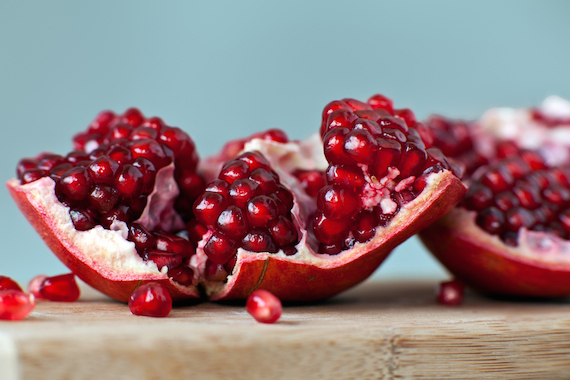
Pomegranate juice has important anti-inflammatory and antioxidant properties. Pomegranates are one of the highest antioxidant-containing fruits. Some studies report that patients with prostate cancer who consume pomegranate juice daily show slower cancerous growth and higher lipid resistance to oxidation. The main antioxidants present in this fruit are flavonoids, tannins and ellagic acid. The activity of its antioxidants would be even superior to that of green tea and red wine.
Benefits of pomegranate juice
The major antioxidants present in this fruit are flavonoids, tannins, and ellagic acid. The antioxidant activity of these three antioxidants is even greater than those found in green tea and red wine.
Research has shown that pomegranate juice has the ability to increase antioxidant activity in the blood and considerably reduces the growth of prostate cancer, colon cancer and breast cancer.
Some studies show that, in patients with prostate cancer, the daily consumption of pomegranate juice slows the growth of cancerous cells and increases the resistance of lipids to oxidation. Daily consumption of pomegranate juice divides the speed of cancerous growth in the prostate by three.
How to eat it?
Even if pomegranate seeds contain a lot of antioxidants, pomegranate juice contains even more. To get pomegranate juice, the entire fruit is pressed; including the white membrane, which is the main source of antioxidants.
Drinking the juice directly from the fruit is even better. With your hand, roll the pomegranate on a hard surface to break the seeds without breaking the rind. Pierce the rind, slide a straw in, and drink up! About 225 ml of pomegranate juice daily is recommended.
Grapes
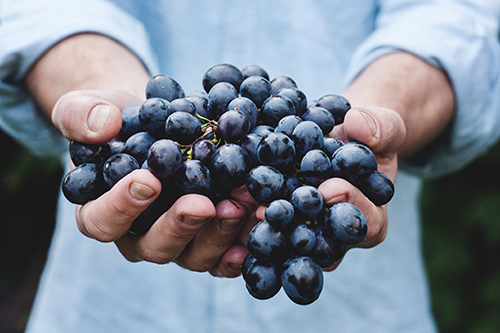
Rich in polyphenols, powerful antioxidants, the grape has protective properties that act at different levels. It protects the cardiovascular system by slowing down its ageing, it limits the formation of bad cholesterol, and improves the resistance of the blood vessels. In addition, resveratrol found in grapes but is mostly found in red wine, is a molecule that affects genes responsible for ageing, activates cellular repair mechanisms, helps increase cellular longevity, and has an incredible capacity for slowing tumour growth.
Benefits of grapes
Grapes are a great source of phytonutrients, mainly phenols and polyphenols, and contain other important vitamins such as vitamin K, vitamin A, vitamin C, vitamin B6, thiamine, riboflavin, niacin and folate. They also contain minerals like potassium, calcium, magnesium, phosphorus and sodium. Grapes have high water content that helps keep the body hydrated, and also contain dietary fiber, healthy carbs, antioxidants and moderate amount of protein.
Flavonoids, like myricetin and quercetin, in grapes help the body to reduce the damage caused by free radicals and slow down aging. Due to its high nutrient content, grapes also play an important role in ensuring a healthy and active life, and is indicated for all those whose energy needs are important, like men under treatments for prostate cancer or their caregiver.
Resveratrol contained in grapes is the first natural component that is capable of blocking or stopping different stages of cancer development for a number of different cancer types. It is effective in all three steps of cancer development: initiation, promotion, and progression.
Resveratrol fights cancer in various ways—from blocking estrogens and androgens to gene control. It works against a large number of cancers at both the prevention level as well as the treatment level.
Grape seed oil
There are quite a few important health benefits of grape seed oil including its ability to lower inflammation, protect the heart, boost the immune system, prevent cancer, stimulate cognitive activity, shield the skin, rejuvenate the hair, prevent chronic disease, eliminate dandruff and balance blood sugar levels, among others.
Grapes should be avoided if
- You are allergic to aspirin because it contains a large quantity of salicylate, one of its components.
- You have sensitive intestines (during or following a radiation therapy), as seeds are often irritating.
- You have diabetes because it contains a lot of sugar. If so, talk to a dietician or nutritionist on your health care team, if not to your doctor.
How to eat them?
- Low in saturated fat and high in unsaturated fats, grape seed oil can be used for cooking, marinating meats, in salads or fondues.
- Or any other recipe from your web search or imagination
Choosing the right grape
- The grapes must be firm but ripe, as they will not mature once they have been harvested. The stem should be firm, with no mildew. Note that the white film that covers the surface of the grape causes no harm. It is, on the contrary, a sign that the fruit is fresh and that it has not been subjected to excessive manipulation.
Conservation
- A few days in the central part of your fridge. Get rid of excess moisture with a paper towel, then place them in a perforated bag. Rinse before eating.
- Place whole fruits, peeled or not, on a plate. When frozen, place them in a freezer bag.
- Dry raisins. Place in a sealed container, keep cool, dry and away from light.
- Grape seed oil. Once the bottle has been opened, keep it in the refrigerator as the oil oxidizes rapidly.
Cruciferous vegetables
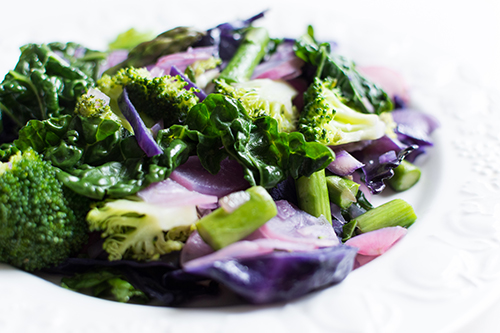
Studies to date show that cruciferous vegetables such as broccoli, cauliflower, and cabbage are the major contributors of anti-cancer properties associated with eating fruits and vegetables. Eating cruciferous vegetables at least 3 to 4 times a week has been linked to a decrease in breast, lung, gastro-intestinal (stomach, colon, rectum), and prostate cancer.
Benefits of cruciferous vegetables
The importance of these vegetables for the prevention of cancer comes from the fact that they are the only food plants to contain large quantities of glucosinolates, a class of inert compounds, but which are transformed into potent anticancer molecules upon chewing.
Of all plants, cruciferous vegetables are probably the most diverse in terms of the anti-cancer properties of their phytochemical molecules. They help the body to eliminate toxic substances that could potentially lead to cancer, prevent tumour development, slow the growth of cancerous cells, stimulate the programmed cellular death of cancerous cells and block angiogenesis i.e. the formation of new blood vessels from pre-existing vessels allowing cancerous tumors to live.
Cruciferous vegetables also have antibiotic bactericide properties that are particularly efficient against the bacteria responsible for gastric ulcers. They may also play an important role in the protection against stomach cancer.
How to eat them?
- Cruciferous vegetables should be eaten raw, lightly steamed or poached, or lightly stir-fried with olive oil in a wok, or in any other recipe from your web search or your imagination.
- Frozen vegetables undergo a high-temperature blanching during processing that lowers their overall anti-cancer properties.
- To ensure the release of active molecules, remember to chew well.
Garlic, onions, shallots, chives and even leeks
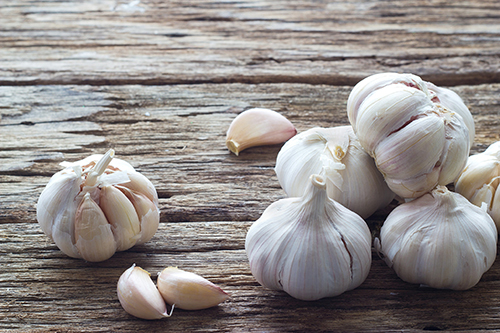
Alliums (members of the garlic family) are effective against prostate cancer. Studies show that the sulphur compounds of vegetables from the allium family play an important role in the prevention of certain digestive system cancers (esophagus, stomach, and colon), prostate cancer, lung cancer, and breast cancer. Moreover, the curative properties of “these allium sulphur compounds induce the death of cancerous cells”. Garlic is possibly the oldest example of a plant used as much for its nutritional properties as its positive impacts on health.
Benefits of alliums
Considéré par les Égyptiens et les Grecs comme un aliment qui donnait force et endurance (les premiers Olympiens étaient gavés d’ail avant les compétitions, ce qui en fait la première substance améliorant les performances athlétiques de l’histoire!), l’ail était aussi un ingrédient indispensable aux médecines traditionnelles des premières civilisations, étant utilisé depuis la plus haute antiquité comme remède à une grande variété de conditions, allant des infections aux problèmes de circulation, de respiration ou de digestion.
Plusieurs études populationnelles indiquent que les personnes qui consomment régulièrement des légumes de la famille de l’ail (ail, oignon, échalote, ciboulette, poireau) sont moins à risque de développer certains types de cancers, en particulier ceux du système digestif (estomac, œsophage, côlon). Un effet protecteur contre les cancers de la prostate, du pancréas et du sein a aussi été rapporté.
L’ail et ses proches parents représentent donc des végétaux indispensables à la prévention du cancer; en l’occurrence, il importe d’en manger le plus régulièrement possible. L’Organisation mondiale de la santé recommande aux adultes de consommer quotidiennement de 2 à 5 g d’ail frais (soit environ une gousse).
How to eat them?
- Preferably crushed or chopped with a little bit of olive oil. The active molecules are released and are more easily absorbed.
- If possible, eat garlic raw or add it to cooked dishes at the end of cooking as sulphur compounds are destroyed by heat. To obtain all its benefits, it is recommended that you eat two cloves, about 6 g, of garlic a day.
- Onions: Do not rinse peeled onions under running water as it will remove all anti-cancer properties!
Dietary fibre
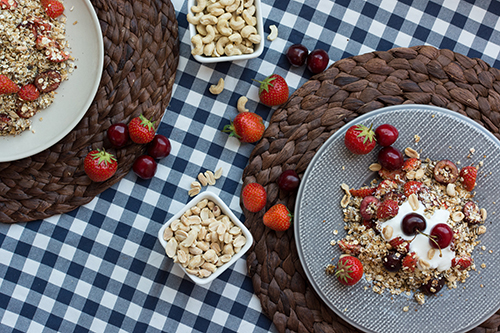
We find these substances in all plant-based foods such as fruits, vegetables, and untreated or unaltered grains. Most foods contain a mixture of the two types of fibres: soluble and insoluble. A diet rich in dietary fibre can help reduce chances of developing certain types of cancer; prostate cancer in particular, namely prostate cancer.
Benefits of fibres
Dietary fibre has many benefits:
- It delays the absorption of carbohydrates, so blood glucose levels rise less after a meal.
- It helps reduce bad cholesterol in the blood, thereby helping to prevent cardiovascular disease.
- It contributes to healthy weight management due to its satiating effect (full feeling).
- It stimulates the growth of beneficial intestinal bacteria (prebiotic effect).
- It prevents constipation by promoting bowel regularity.
Most Quebecers don’t get enough dietary fibre (15 grams of fibre on average, when they need between 25–35 grams). Yet, fibre is in all our food and is easy to incorporate into your diet if you choose the right foods.
Two types of fibre
There are two types of dietary fibre: insoluble and soluble. Each type of fibre plays a different role in the body. It is important to note that not all types of fibre have an impact on blood glucose (sugar) levels.
Insoluble fibre
Insoluble fibre acts like little sponges in the intestines. By swelling up with water, it increases stool volume and helps regulate bowel function. Because it slows digestion, it helps you feel full which in turn contributes to appetite and weight control.
- Cereals and wheat bran
- Whole-grain foods
- Vegetables and fruit
- Nuts and seeds
- Legumes and pulses (kidney beans, lentils, chickpeas, etc.)
Soluble fibre
Soluble fibre forms a gel when mixed with water and can help lower cholesterol levels in the blood. Furthermore, it acts like a filter in the intestines, slowing the absorption of carbohydrates. Please note that you must eat a very large quantity of soluble fibre every day to see any impact on blood glucose (sugar) control.
- Psyllium and enriched cereals (e.g.: Kellogg’s All-Bran Buds®)
- Cereals and oat bran
- Legumes and pulses
- Fruits high in pectin (apples, oranges, grapefruit, strawberries, pears, etc.)
- Vegetables (asparagus, green beans and green peas, Brussel sprouts, carrots, etc.)
- Barley
- Flaxseeds, chia seeds
New types of fibre are also being added to many food products today. They don’t have the same nutrient value as natural fibre found in food but they offer some advantages, mainly their prebiotic effect and effect on bowel regularity.
How to eat them?
Here are helpful tips for adding fibre to your diet…
- Add wheat bran, oat bran, or psyllium (All-Bran Buds®) to your breakfast cereal, yogurt, and homemade muffins.
- Add fresh fruit, dried fruit, nuts, or seeds to your breakfast cereal.
- Eat fresh fruit with its peel instead of fruit juice.
- Keep a stock of frozen vegetables and fruit so you always have them in a pinch.
- Replace half the all-purpose flour with whole-wheat flour in your cookie, muffin, and cake recipes.
- Use raw vegetables and fruit slices as snacks or with yogurt-based dips.
- Add almonds, sesame seeds, pumpkin seeds, sunflower seeds, or flax seeds to your salads, yogurt, or make a snack of them. (Note: nuts are high in fat and calories. Eat them in moderation: 1–2 tbsp. or 15–30 mL).
- Incorporate legumes into your diet: whole, pureed, in chili, as humus, in salad, or in soups. Replace some of the meat in your spaghetti sauce, shepherd’s pie, or meatloaf with legumes like beans or lentils.
- Choose whole-grain breakfast cereals and breads.
- Try whole grains like amaranth, oats, spelt, millet, quinoa, brown or wild rice, triticale, and barley.
Increase your consumption of fibre progressively to give your digestive tract time to adapt and don’t forget to stay well hydrated all day to ensure that fibre can do its job properly.
Soy protein
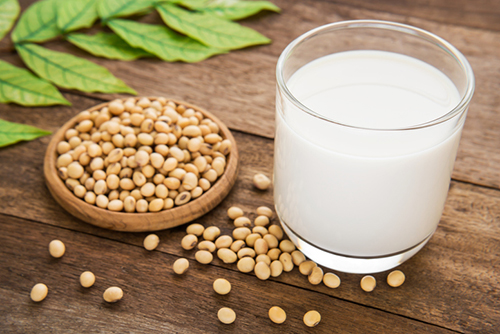
When it comes to prostate cancer prevention, we know that soy contains natural estrogen that can balance androgens. There are also other hormonal mechanisms that use soya to inhibit the development and progression of cancer. It is recommended that patients, who wish to take this treatment in addition to the usual prostate cancer treatments, take 50–60 mg of soy protein each day.
Benefits of soy protein
Soya contains antioxidants, called polyphenols, which can inhibit the growth of tumours. We find them in: soy cheese, soybeans, soymilk, soy nuts, powdered soy protein, soy yogurt, tempeh, tofu, soy cereal, and soy meat substitutes.
We also suggest reducing or eliminating red meat from your menu. Ideally, only 15% of calories ingested each day should come from fat.
Soybeans are part of the legume (pulse) family, like kidney beans, dry peas, lentils, and chickpeas. Native to Asia and cultivated in China for over 13 000 years, soya is one of the first foods grown by man.
Nutritional value
Soy is a food that has a surprising nutritional value. A cup of soybeans (250 mL) contains as much protein as 100 g of meat, poultry, or cooked fish. Also, contrary to other legumes, the quality of protein in soy is comparable to the protein found in meat. Soya is also an excellent source of minerals such as calcium, iron, and zinc.
All legumes, soya included, do not contain cholesterol. And even if the fat content of soy is slightly higher than other legumes or pulses, it’s all good fat like monounsaturated and polyunsaturated Omega-3.
How to eat them?
Soy products are made from soybeans. Soya bean products are finding their way into our menus and onto our shelves. Today, you can find a variety of soy products in every grocery store. Get informed about all the options available to you.
Tofu
Tofu is an extremely versatile ingredient; neutral to taste, it is sold in a variety of textures. Firm or extra firm tofu can be used in vegetable stir-fries, soups, pasta sauces, etc. Silken tofu is ideal for creamy sauces, dips, creamy deserts, smoothies, or soups.
Roasted soybeans
The beans are soaked in water and then roasted in oil or dry roasted in the oven. With a taste similar to peanuts, roasted soybeans can be purchased unsalted, salted, or in a variety of flavours.
You’ll be surprised to learn that soybeans are just as nutritious as almonds. Roasted soya beans contain twice as much protein and 30% less fat. Keep in mind, roasted soybeans are still high in fat, a single 40-gram portion contains 11 g of fat.
Soy beverages
Soy beverages are made by grinding soya beans to get a milky-looking liquid. The protein content of soya beverages is dependent on the amount of soy present. On average, one cup (250 mL) has about 5–9 g of protein. In comparison, a glass of milk contains around 8.5 grams. To ensure that your protein intake is sufficient, soy beverages that contain more than 7 g of protein per 250 mL are recommended. Unless soy drinks are enriched it can never replace milk.
Levels of calcium, zinc, and vitamins D, B3, B12, and A in fortified soy beverages are equal to if not greater (vitamin B12) than those found in milk. Another benefit of soy drinks is iron content; soy drinks have 8–14% of our recommended daily iron intake. This means that there is 1–2 mg of iron in every cup.
Soya drinks can either be consumed as is or used as a substitute for milk in tea, coffee, cereal, sauces, and soups, etc.
Omega-3
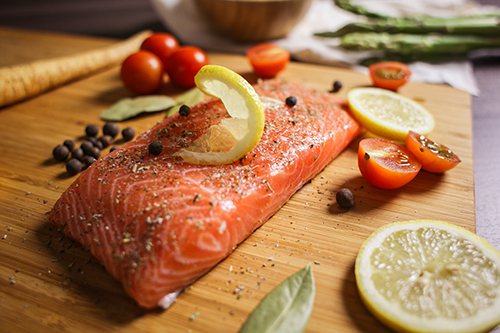
Studies show a correlation between eating fish rich in omega-3 and a decrease in the risk of developing certain breast, ovary, prostate, or colon cancers. Omega-3 has demonstrated the ability to slow the production of inflammatory molecules that promote the development of cancer, promote cellular death by apoptosis, and inhibit the growth of blood vessels that feed cancer cells. Fatty acids play an important role in tissue regeneration and keeping your prostate healthy.
Benefits of Omega-3
We often forget the importance of “good” fat in our regular diet. An example of such are polyunsaturated fats, like omega-6 and omega-3, which are essential for our body to function but that the human body is unable to produce itself. The only solution for this is to get it from our food. Much of the food that we are already in the habit of eating, such as meat, eggs, and vegetables, contains a lot of omega-6. Omega-3, on the other hand, is harder to find in food.
It is important to maintain a good balance between omega-6 and omega-3; the body uses the former to promote inflammation and the latter to reduce inflammation. Nutrient imbalances make the body a fertile breeding ground for diseases like cancer.
Fatty acids play an important role in tissue regeneration and keeping your prostate healthy.
There are 2 types of Omega-3
Fish
- Fish – sardines, herring, mackerel, salmon (Atlantic), rainbow trout, etc., are rich in omega-3. Aim to have 2 servings of fish per week.
- Fish is better eaten fresh. Frozen fish loses omega-3 over time.
- Canned sardines are only good if they are preserved in olive oil and not in sunflower oil which is high in omega-6.
Plant sources
- Sources include fresh walnuts, flax seeds, walnut oil, canola oil, soya beans, tofu, etc.
- Flax seeds are a source of phytoestrogen that also contain fatty acids that can be beneficial when it comes to prostate cancer. You should not surpass the recommended daily intake of 45 g as flax seeds can lead to digestive problems. The seeds can be ground and mixed with other foods or consumed in the form of flax seed oil. Flax seed oil can be refrigerated for up to 3 months if kept in an opaque bottle that keeps it from oxidizing.
Green tea
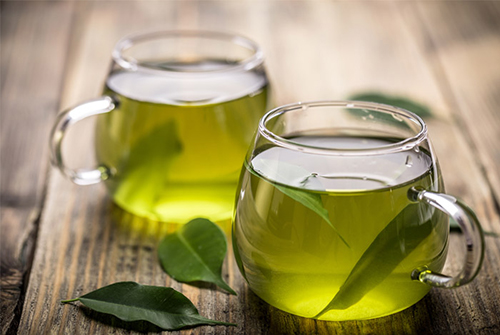
Similar to soy, green tea has a lot of beneficial medicinal properties. Green tea is rich in catechins (polyphenols) that have important anti-tumour properties. Green tea is also a powerful antioxidant, a detoxifier. It facilitates the death of cancer cells and acts on the process of angiogenesis. In the laboratory, it increases the effects of radiotherapy on cancer cells. Drinking green tea can be beneficial to men with prostate cancer.
Benefits of green tea
Green tea is an exceptional source of high-potency anti-cancer molecules that make it one of the key elements in any anti-cancer diet. Whether the teas are green, black or wulong, they are all from the same plant. But their characteristics change according to the drying process of the leaves.
During the fermentation process used for the manufacture of black tea, modifications occur in the nature of the polyphenols causing their oxidation and the production of the black pigments. This oxidation eliminates almost all the anti-cancer potential of polyphenols. Green teas are the ones that undergo the least transformation.
Studies carried out in recent years have shown the benefits of green tea on cancer prevention especially for bladder, prostate, breast and stomach cancers. It is a powerful antioxidant, a detoxifier. It facilitates the death of cancer cells and acts on the process of angiogenesis. In the laboratory, it increases the effects of radiotherapy on cancer cells.
How to drink it?
- An infusion of less than 5 minutes only extracts 20% of the total polyphenol content while infusing the tea for 8–10 minutes extracts all of the polyphenol present in the tea. It is recommended that you infuse 2 g of green tea for 10 minutes and drink it within the hour.
- Adding lemon to your green tea multiplies by 5 the amount of catechins absorbed by your body.
- However, a study published in the medical journal European Heart Journal states that you should never drink green tea with milk. Milk destroys the benefits of green tea and decreases the catechin concentration in the tea.
Dark chocolate
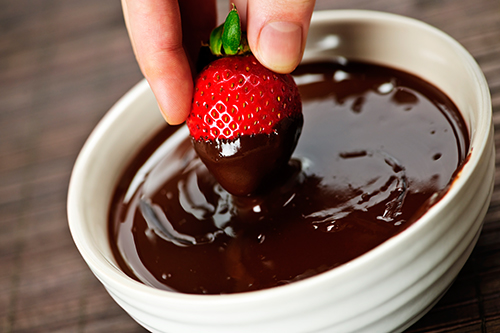
Cacao is known for its high polyphenol content from which it gets its antioxidant properties. It is one of the richest flavonoid-containing foods, especially in terms of catechin and epicatechin. Lab studies show evidence of dark chocolate slowing the development of some cancers and countering the growth of cancer cells.
Benefits of dark chocolate
A single square of dark chocolate contains twice as many polyphenols than a glass of red wine and almost as much as a glass of steeped green tea.
How to eat it?
- Which chocolate do you choose? Not all chocolate has the same amount of cacao, thus not all chocolate has the same amount of flavonoids. Cacao powder has the highest flavonoid content, followed by dark chocolate.
- Adding milk products to chocolate inhibits flavonoid absorption.
- White chocolate does not contain flavonids because it is made from cacao butter.
- To fully benefit from polyphenols, the daily recommended serving of dark chocolate (at least 70% cacao) is 20 grams.
Red wine

Red wine is a great source of polyphenols, the main one being resveratrol. Resveratrol found in grapes but most abundant in red wine, is a molecule that affects genes responsible for ageing, activates cellular repair mechanisms, helps increase cellular longevity, and has an incredible capacity for slowing tumour growth.
Benefits of red wine
It is the first natural compound that is capable of blocking or stopping different stages of cancer development for a number of different cancer types. It is efficient in all three steps of cancer development: initiation, promotion, and progression.
Resveratrol fights cancer in various ways from blocking estrogens and androgens to gene control. It works against a large number of cancers at both the prevention level as well as the treatment level.
The large amount of resveratrol in red wine is due to the long fermentation of grape pulp, skin, and seeds. Polyphenols are mostly concentrated within the seeds of the grape. Rosés and white wines, having a much shorter fermentation period, contain much less resveratrol. Moreover, the bond with the alcohol allows for a better extraction of the resveratrol.
During the conservation phase, wine is protected against oxygen to avoid oxidizing its active compounds. This is not the case for raisins.
A laboratory analysis showed that resveratrol is particularly effective in preventing the development of breast cancer, colon cancer, and oesophageal cancer.
How to drink it?
Drinking one or two 125-mL glasses of red wine a day for men or one glass for women is the optimal amount needed to get these beneficial results. Drinking more, according to some studies, would produce the opposite effect. N.B.: Burgundy wine is extremely rich in resveratrol.
Vitamin D-E and Selenium

Vitamin D
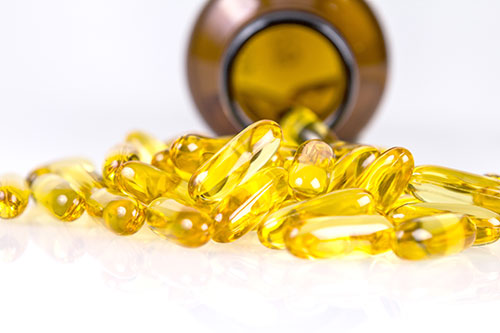
Contrary to its name, vitamin D is actually not a vitamin but a hormone that is synthesized by sunlight. The majority of Quebecers, particularly the elderly, are vitamin D deficient, especially during winter. Research studies suggest that vitamin D deficiencies may be linked to the development and growth of prostate cancer.
Recommendations
Because of Canada’s northern latitude the sun’s rays are weaker in the fall and winter. While vitamin D supplements are recommended for all Canadians, men with prostate cancer or at high risk for prostate cancer in particular should take it. Doses of up to 1500 IU appear to be safe and are recommended.
If you are at risk
Ask your doctor if you should take 1,000 or 1,500 international units (IU) a day during the fall and winter months, or all year around. It is important to understand that vitamin D supplements should be used with caution and we recommend following the Health Canada guidelines.
The 20 best sources of vitamin D
- Swordfish, grilled = 100 g (3 ½ oz.)
- Eel, grilled = 100 g (3 ½ oz.)
- Salmon, grilled or poached = 100 g (3 ½ oz.)
- Salmon, canned = 100 g (3 ½ oz.)
- Salmon, smoked = 100 g (3 ½ oz.)
- Red tuna, grilled = 100 g (3 ½ oz.)
- Atlantic herring, pickled = 100 g (3 ½ oz.)
- Trout, grilled = 100 g (3 ½ oz.)
- Walleye, grilled = 100 g (3 ½ oz.)
- Halibut, Atlantic or Pacific, grilled = 100 g (3 ½ oz.)
- Atlantic Herring, grilled = 100 g (3 ½ oz.)
- Egg, yolk, raw = 2-4 large yolk (80 g)
- Pike, grilled = 100 g (3 ½ oz.)
- Milk, cow, 0% to 3.25% MG = 250 ml (1 cup)
- Enriched soy beverage = 250 ml (1 cup)
- Enriched rice beverage = 250 ml (1 cup)
- Flounder or sole, grilled = 100 g (3 ½ oz.)
- Atlantic sardine, canned = 100 g (3 ½ oz.)
- Tuna, canned = 100 g (3 ½ oz.)
- Beef liver, braised or sautéed = 100 g (3 ½ oz.)
Source: Passeport santé
Selenium
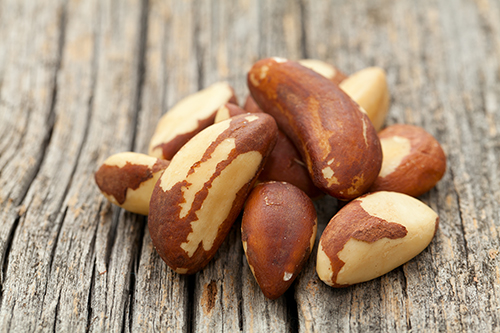
Selenium is found in brewer’s yeast, wheat germ, chicken liver, nuts and seeds, cod, tuna, herring, shrimp, and oysters. Brazil nuts can have relatively high selenium concentrations (839 micrograms/ounce) but they are high in calories and fat. A healthy diet contains 70 micrograms a day.
Toxic in high doses
Selenium must be taken with caution. Large doses can be toxic. Recent Selenium studies have not positively indicated beneficial effects in the prevention of prostate cancer. More study is needed as it is difficult to recommend supplemental selenium given the current evidence.
How to get it?
It is recommended that patients take 100–200 µg (micrograms) of selenium a day.
The 20 best sources of selenium
- Brazil nuts, dehydrated = 60 ml (1/4 cup)
- Pacific oysters, raw or steamed = 100 g (3 ½ oz.) (2 à 4 medium)
- Tuna, canned = 100 g (3 ½ oz.)
- Giblets, turkey or chicken, braised = 100 g (3 ½ oz.)
- Swordfish or flounder, baked or grilled = 100 g (3 ½ oz.)
- Atlantic herring, pickled = 100 g (3 ½ oz.)
- Atlantic sardines, canned = 100 g (3 ½ oz.)
- Mixed nuts, with peanuts, roasted = 60 ml (1/4 cup)
- Clams, canned = 100 g (3 ½ oz.) (13 medium)
- Pork chops, cooked = 100 g (3 ½ oz.)
- Tuna, halibut, code, rockfish, haddock, salmon, baked or grilled = 100 g (3 ½ oz.)
- Shiitake mushrooms, dried = 10 mushrooms (36 g)
- Crab or lobster, steamed or boiled = 100 g (3 ½ oz.)
- Salmon, baked or canned = 100 g (3 ½ oz.)
- Shrimps, raw or cooked = 100 g (3 ½ oz.)
- Lamb, shoulder, braised = 100 g (3 ½ oz.)
- Beef, outside round, braised = 100 g (3 ½ oz.)
- Duck, domestic, roasted = 100 g (3 ½ oz.)
- Ham, regular (11% MG), roasted = 100 g (3 ½ oz.)
- Egg, poached = 1 large
Source: Passeport santé
Vitamin E
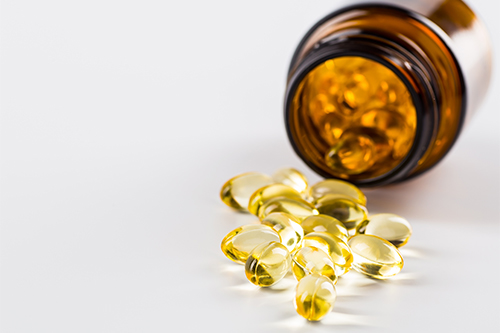
Vitamin E is a major intracellular anti-oxidant. It is typically found in plant-derived oils but is commonly taken in the form of a dietary supplement. Vitamin E has a long been considered safe, but recent studies have put into question the safety of larger doses. Given this new evidence it is recommended that you do not exceed your daily allowance of vitamin E.
How to get it?
- Nuts, grains, vegetable oils, and to a lesser degree, leafy greens, are all good sources of vitamin E.
- Peanuts and pistachios contain less vitamin E than almonds, hazelnuts, and sunflower seeds.
- A daily intake of 15 mg is sufficient.
The 20 best sources of vitamin E
- Wheat germ oil = 15 ml (1 tbsp.)
- Almonds, unbleached, dry roasted, cooked, or dehydrated = 60 ml (1/4 cup)
- Sunflower seeds, dry roasted = 60 ml (1/4 cup)
- Hazelnuts or walnuts, unbleached or dry roasted = 60 ml (1/4 cup)
- Sunflower seed oil = 15 ml (1 tbsp.)
- Saffron oil = 15 ml (1 tbsp.)
- Breakfast cereal, 100 % bran (All Bran brand) = 30 g (1 oz.)
- Pine nuts, dried = 60 ml (1/4 cup)
- Peanuts, oil roasted = 60 ml (1/4 cup)
- Tomato paste, canned = 60 ml (1/4 cup)
- Tomato puree, canned = 125 ml (1/2 cup)
- Brazil nuts, dried = 60 ml (1/4 cup)
- Mixed nuts, oil roasted or dry roasted = 60 ml (1/4 cup)
- Hard roes (fish eggs), various species = 30 ml (2 tbsp.)
- Bran, corn or wheat, coarse = 30 g (1 tbsp.)
- Oil, peanut, olive, canola, or corn = 15 ml (1 tbsp.)
- Avocado = ½ avocado (100 g)
- Sardines, canned, with bones = 100 g (3 ½ oz.)
- Asparagus, boiled or raw = 125 ml (1/2 cup)
- Spinach, boiled = 125 ml (1/2 cup)
Source: Passeport santé
Last medical and editorial review: September 2023
Written by PROCURE. © All rights reserved



